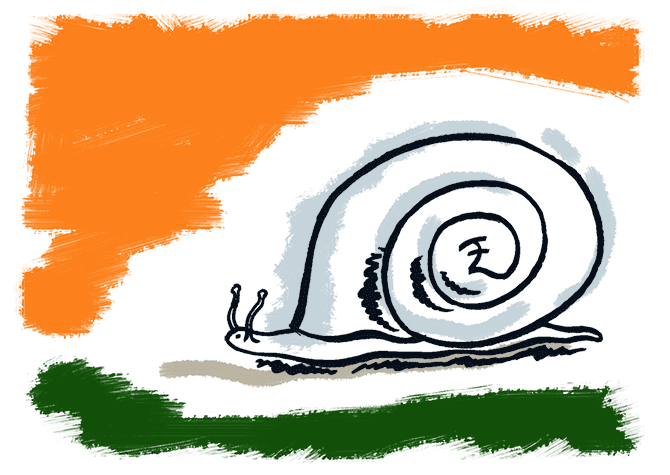We could be on the brink if our export industries actually start losing jobs, says Shreekant Sambrani.
Illustration: Dominic Xavier/Rediff.com

'We did-they did' is how the discourse on the economic slowdown has quickly degenerated into a slanging match between premature doomsayers and equally unwarranted triumphalists.
That is unfortunate. All such blame games are sordid. More importantly in this instance, they shift the collective attention away from the pressing need for action to deal with the situation at hand.
We cannot be in denial by citing selective data. The blip in the growth rate is not a one-off spike but is in fact, a part of the trend, making not just the rating agencies, but also the Reserve Bank of India to revise their growth rate estimates downwards.
Buyers of Mercedes cars matter, but those of Hero cycles matter even more, because they move up the pyramid..
Even the World Bank, ever so politely, calls it an aberration.
“The slowdown may have been exacerbated lately by demonetisation or GSTs' teething troubles, but it is a phenomenon now going on for almost the entire decade,” I had earlier said.
This conclusion emerged from an analysis of the 2003-2008 boom and the causes underlying it.
That period of high growth was a serendipitous result of the global buoyancy, a spurt in Indian IT and ITeS exports and the attendant income surge for a small fraction of aspirational India.
It led to increased spending mainly on high-end consumer durables.
That scenario was bound to play itself out sooner rather than later, because the demand was not likely either to widen (spread to lower income strata) or deepen (more gadgets among the users).
In hindsight, one would have to concur with Ravi Menon, an IT industry analyst who grew up with it. He wonders if we frittered away our exports bonanza.
We failed to invest the gains in creating domestic linkages and improving productivity in areas such as agriculture or creating an effective primary and secondary school system and good healthcare.
We could be on the brink if our export industries actually start losing jobs.
Our demand-driven economic growth of the last decade resembled a needle resting atop a low flat base. We failed to build a pyramid around the needle to protect it from toppling.
A smart young chief executive of the Indian subsidiary of a multinational capital goods manufacturer observed that if the economy is to be driven by consumer spending, we need to create new consumers constantly.
Buyers of Mercedes cars matter, but those of Hero cycles matter even more, because they move up the pyramid. A household cook could switch from a bicycle to a scooter, and to a better scooter in a few years, with someone moving up to buy her bicycle. The economic blip is then temporary.
Some pundits advocate pump-priming through increased public spending on infrastructure.
This is not going to do the trick, in view of the long gestation period compounded by our extraordinarily dilatory decision process. The real importance of infrastructure lies elsewhere.
In our self-congratulatory mood on growing service exports, no one cared to prepare for sustaining the next export wave that needed to boom, of the manufactured goods.
One can say without fear of contradiction that the infrastructural and logistics bottlenecks for manufacturing exporters are absolutely real and challenging.
Unlike his Chinese counterpart, the Indian exporter has to maintain a full-fledged team just for managing logistics and export regulation compliance. We have recently heard incremental improvements in infrastructure being extolled as major achievements.
In other emerging markets, an expressway or a high-speed rail link would be one among the many that need to come up.
The short point is that sustained growth is never the result of just one initiative, certainly not driven by consumption alone.
We need to sustain domestic and export markets, high-end and low-end goods, services and manufactured goods.
In reality, we have been steadily losing ground even in our traditional areas of strength.
The chief economic advisor, Arvind Subramanian, has pointedly highlighted in Economic Survey 2016-17 clothes and shoes as areas of low-skill manufacturing for India to reclaim.
But this home-grown advice seems to be lost. Ruchir Sharma had said recently, 'Vietnam, Bangladesh and Cambodia,… have seen a surge in manufactured exports in recent years, …by taking share from China in low-end goods from toys to textiles.'
'India’s continued lack of success in these industries may be the single biggest reason why it keeps falling short of being the next China” (The Times of India, October 4, 2017).
China wrote the book on sustained growth.
T N Ninan makes a telling point of how clearly China is focussed on maintaining its enviable high growth profile, in sharp contrast to India. It has, he says, stepped on the accelerator and “reclaimed … its mantle as the world’s fastest-growing large economy… China expects to create 11 million urban jobs this year”.
In Through the Looking Glass, Alice wonders why she has remained in the same place despite running fast.
The Red Queen tells her, “[I]t takes all the running you can do, to keep in the same place. If you want to get somewhere else, you must run at least twice as fast as that!”
India needs to heed this advice seriously lest it be mired in the blunderland of slowdown.
Shreekant Sambrani is an economist.











